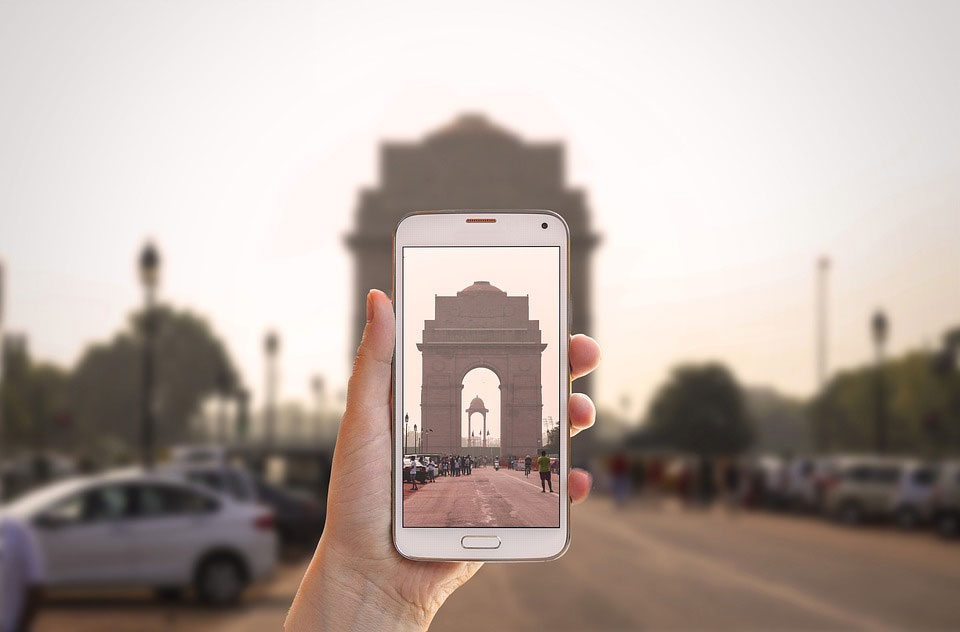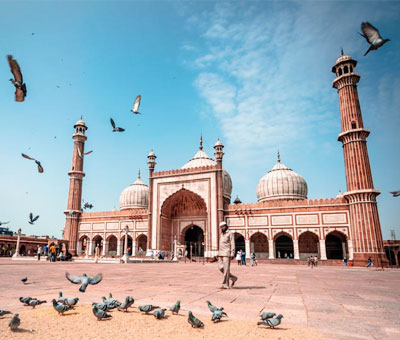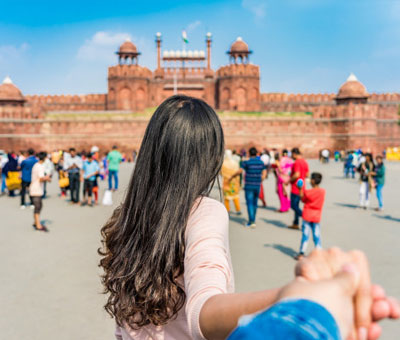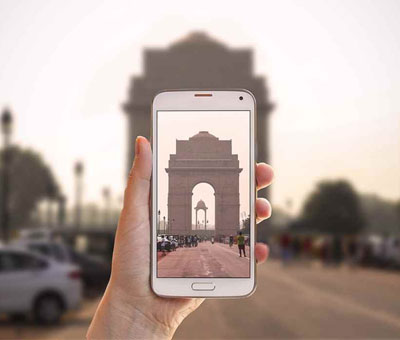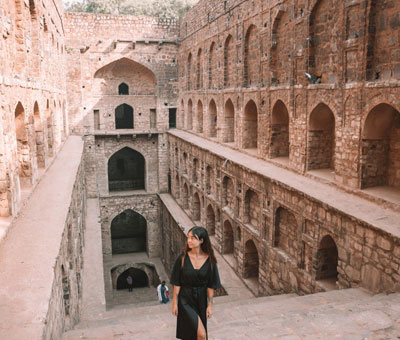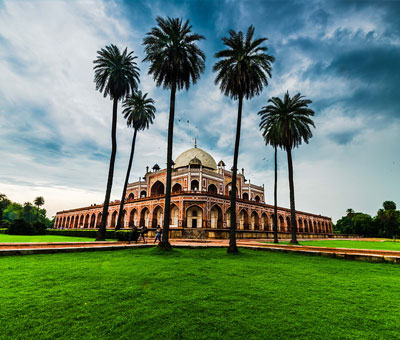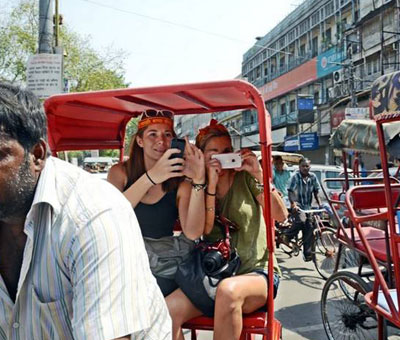Tourist Places to Visit in Old Delhi
Old Delhi, about 6 km (4 miles) north of the city center, is in a state of decay. The old havelis (mansions) that line the galis (side lanes) of Chandni Chowk, the main artery of this old district, are architecturally stunning but cry out for repair. The whole area is extremely crowded. Still, Old Delhi’s monuments—Lal Qila and Jama Masjid—are magnificent, and Chandni Chowk is great fun to explore.
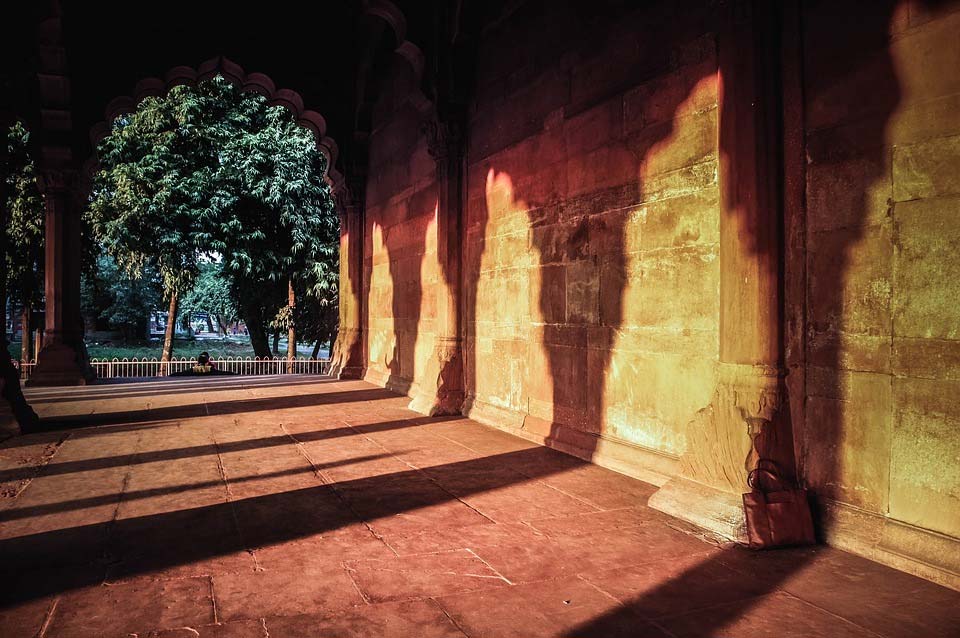
Tourist Places To Visit in Delhi
A Good Walk in Old Delhi
Swan Tours organizes regular walking tours for visitors in Delhi, Start in Old Delhi with a morning tour of Lal Qila, Emperor Shah jahan’s sprawling 17th-century capital. From here set your sights on a red, rectangular three-story building (look for a flock of pigeons flying overhead) on the opposite side of Nataji Subhash Marg, the busy street in front of the fort: This is the Charity Birds Hospital, a delightful hospital that is as much a respite for human visitors as for the nonhuman patients tended inside.
After leaving the hospital, return to Nataji Subhash Marg and walk a short distance north to the famous Chandni Chowk. Walk about four blocks down this crowded thoroughfare to the marble-faced Sisganj Gurdwara, a Sikh shrine. Continue east on Chandni Chowk and cross three more galls; then turn left on Gali Parante Wall, whose entrance is almost directly opposite a large Central Bank of India. Continue down Gall Parante Wali until you see a, signboard for the Vaishali Sahai Center at a fork in the road. Turn left onto Motiwali, which leads directly into Kinari Bazaar, a bridal-trimming market where Hindu families buy every item required in their symbol-rich wedding ceremony: garlands, beads, colorful ribbons, attractive boxes for sweets and gifts, masks, and statues of gods.
Delhi Tour Packages
Pricing and Itinerary
The Bombay Beads Centre at 2030 Kinari Bazaar is your next land-mark; directly across from this shop is one of Chandni Chowk’s most beautiful lanes, Naughara Gali, where beautiful old havelis, home to a community of Jains, are done up, in art-deco colors—aquas, pinks, yellows. At the end of this peaceful lane is the exquisite Jain Sweitana Temple, with a white-marble elephant head on the railing and gleaming brass doors. Even if the temple is closed, Naughara Gali is an oasis, an ideal temporary escape from Chandni Chowk’s bustle.
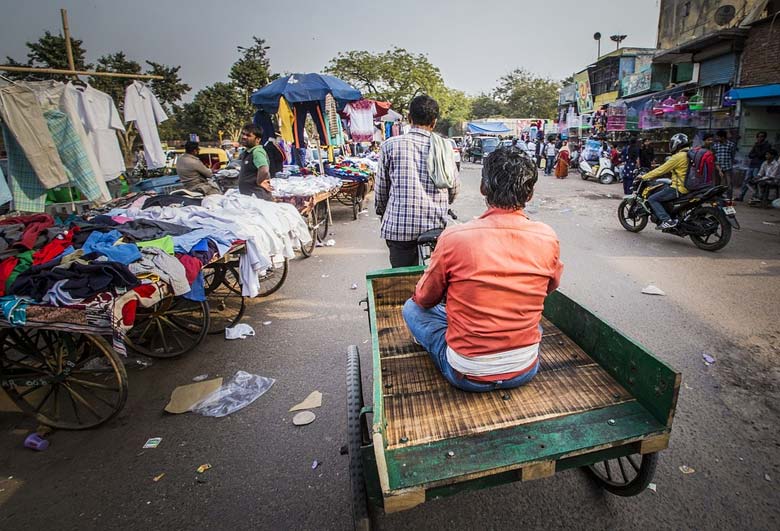
Street Shopping in Chandni Chowk Delhi
Return to Kinari Bazaar and turn, right. If it suits your fancy, stop in a shop called Shivam Zari Palace and spend an hour or two dressing a tiny bronze statue of Gopal (baby Krishna) in an outfit of your choice, including a headpiece, necklace, bangles, and a throne. The cost for your finished memento is less than Rs. 350, depending on the size of the statue you choose. This is a novel way to learn a bit about Hinduism, with the shop owner your charming guru.
Continue down Kinari Bazaar until it intersects with Dariba Kalan, the “Street of Silver.” Visit the silver shops on your left (ate Shopping, below) or turn right and head down Dariba Kalan, which is lined with tiny stores selling gold and silver jewelry and artifacts. At the end of Dariba Kalan, turn right onto a broad street that leads through the brass and copper district. At a small corner shop, Prem Fireworks turn right and walk about 20 ft, then turn left and walk under an arch that says ES-TATE HANDICRAFTS. Head up Chah Rahat, a typical narrow lane with old wooden balconies and verandas.
When Chah Rahat lane opens into a small courtyard, make a hairpin turn to the left. Follow the arrow on a sign that reads SINGH COPPER AND BRASS PALACE and head down Chah Rahat. After about 30 ft, a second sign directs you down an alley on the right. Singh’s emporium is filthy—dress for the occasion. But every floor is a great place to poke around, filled with treasures both cheap and supremely expensive.
From Singh’s, return to the courtyard and Chah Rahat and walk left down a short, narrow lane. At the end of the lane you’ll see the splendid .Jama Masjid, preceded by an unexpected bazaar of small shops selling tools of every conceivable design.
At the end of this long tour, take a cycle-rickshaw to either Karim’s or Chor Bizarre for a typical Muslim meal in Old Delhi.
Timing
Allow a full day for this tour, and make sure the day will not be obscenely hot. Avoid Friday, when the fort museum is closed and entrance to the mosque is tricky for non-Muslims. Most shops in Chandni Chowk are closed on Sunday.
List of 22 Tourist Places To Visit in Old Delhi
#1. Chandni Chowk
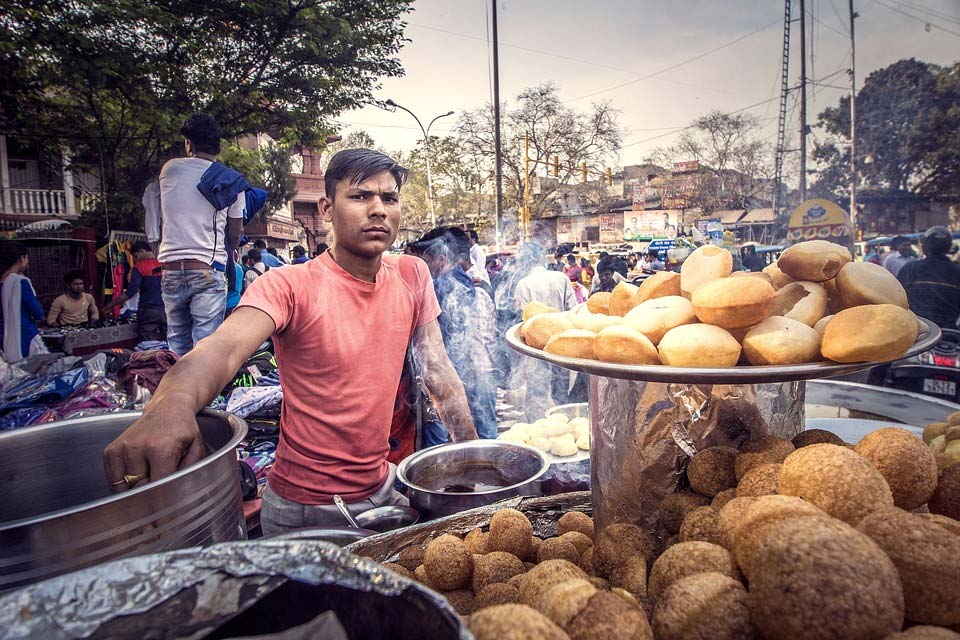
Chandni Chowk Delhi
Chandni Chowk is Delhi’s former imperial avenue, where the Mogul emperor Shah Jahan rode at the head of his lavish cavalcade. Today, bullock carts, taxis, private cars, dogs, cows, auto-rickshaws, bicycles, horse-drawn tongas, and pedestrians plow indiscriminately through the congestion. If you suffer from claustrophobia you’re in trouble; if not, you’re in for an adventure. As in the days of the Moguls, astrologers set up their charts on the pavement; shoemakers’ squat and repair sandals and other leather articles, blithely ignoring the human swirl around them; sidewalk photographers with old box cameras take pictures for a small fee; medicine booths conceal doctors attending to patients; and oversize teeth grin from the windows of dentists’ offices. Peer through a portico and you might see men getting shaved, silver being weighed, or any other conceivable form of commerce, while outside a cow lies complacently on the street.
#2. Charity Birds Hospital
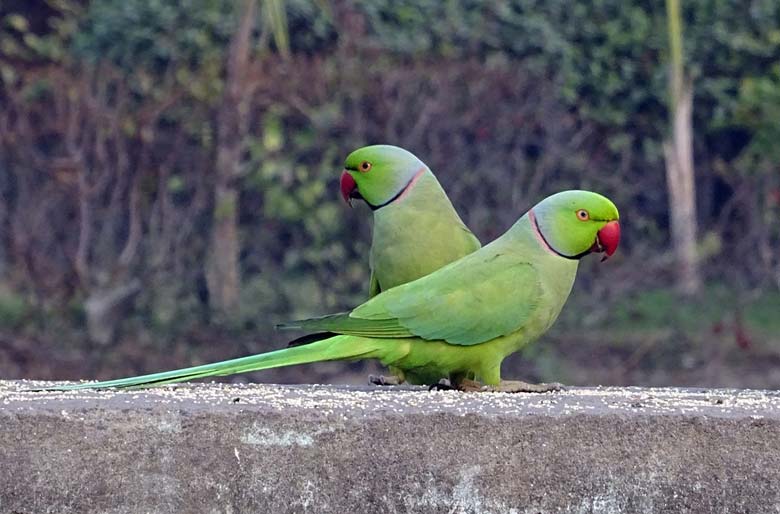
Charity Birds Hospital in delhi
Across from Lal Qila is a delightful and unusual attraction: a hospital not for humans, but primarily for birds. Founded by Jams in 1956, the hospital is modest, but it shows how tender loving care can stretch limited funds. Vegetarian birds (and rabbits) are treated inside on three floors, and carnivorous birds and other needy animals are treated in the courtyard. There’s even an intensive-care ward and a research laboratory. Bathed, fed, and given vitamins, the healthy birds refuse to leave, and that’s how you can spot the building—flocks of birds swirl around its roof.
#3. Gali Parante Wali
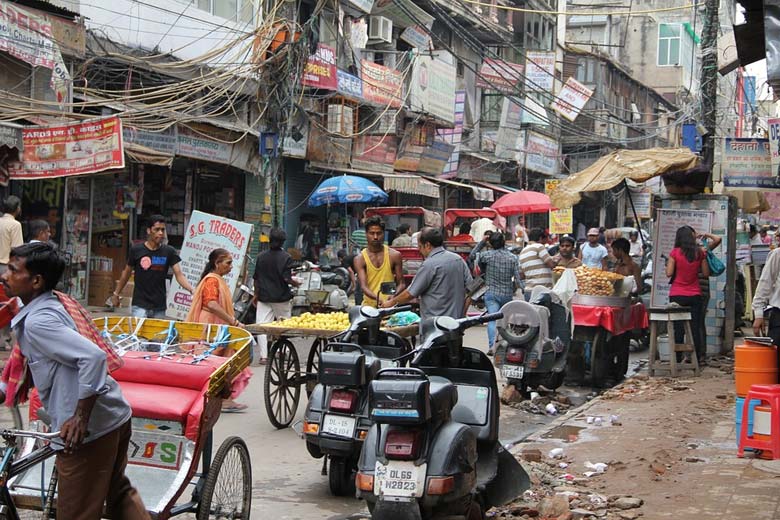
Gali Parante Wali Delhi
This congested, narrow lane is filled with shops selling exquisite saris, including the well-known Ram Chandra Krishan Chandra’s, where you can peruse some of the finest fabrics in India. The lane is named for the fabulous parathas (flat fried breads) also sold here, in simple open-air eateries. Stuffed with a variety of fixings, such as radishes, cheese, and seasonal vegetables, they’re a real treat (just bring Handi Wipes).
#4. Jama Masjid one of the best tourist place in Delhi
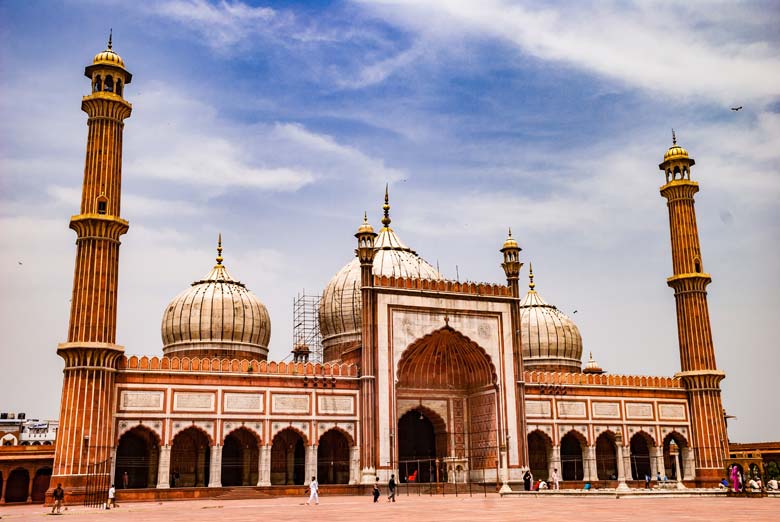
Jama Masjid Delhi
A splendid Islamic declaration in red sandstone and marble, India’s largest mosque was completed in 1656 by 5,000 laborers after six years of work. It was the last monument commissioned by the Mogul emperor Shah Jahan. Three sets of broad steps lead to two-story gateways and a splendid yard with a square ablution tank in the center. The whole space is enclosed by pillared corridors with domed pavilions in each corner. Thousands collect to hope in this yard, particularly on Friday, which is why the Jana Masjid is also called the Friday Mosque.
The mosque is typically Mogul, with an onion-shaped dome and tapering minarets. However Shah Jahan included an innovation: the novel stripes adding and down the well-proportioned marble domes. The entire structure breathes peace and serenity– climbs up the open minaret to see how carefully the mosque contrasts with the business streets around and below it. Inside the prayer hall (which you can only enter after a routine purification at the ablution tank), the pulpit is sculpted from a single piece of marble. In one corner is a room where Shah Jahan in-stalled the marble footprints of the Prophet Mohammed.
#5. Lal Qila (Red Fort)
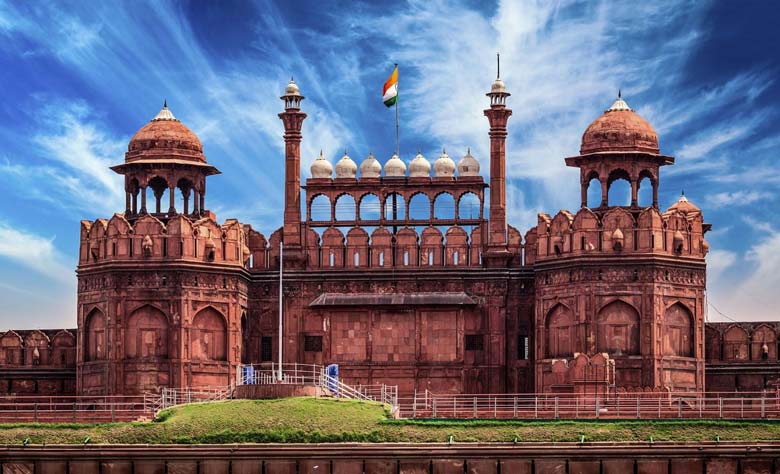
Lal Qila Delhi
This is the greatest of Delhi’s cities, outdoing even Lutyens’s Imperial City in majesty. Built behind red sandstone walls i that gave the fort its name, the Red Fort is Shah Jahan’s 17th-century statement of Mogul power and elegance. Try to imagine imperial elephants swaying by with their mahouts (elephant drivers), a royal army of eunuchs, court ladies carried in palanquins, and other vestiges of Shah Jahan’s pomp.
The view of the main entrance, called Lahore Gate, flanked with towers and facing Chandni Chowk, is blocked by a barbican (gatehouse), which the paranoid Aurangzeb included for his individual security- much to the sorrow of Shah Jahan, his daddy. From his jail, where he was held captive by his power-hungry child, Shah Jahan composed, “You have actually made a bride-to-be of the palace and thrown a veil over her face.”
Once you pass through the main gate, continue along the Chatta Chowk (Vaulted Arcade), originally the shopping district for the royal harem and now a bazaar selling rather less regal goods. The arcade leads to the Naubat Khana (Imperial Bandstand), a red sandstone structure where music was played five times daily. This is the main gate-way to the fort; beyond this point, everyone but the emperor and princes had to proceed on foot, a rule that was observed until the Indian Mutiny of 1857.
An expansive lawn, once a courtyard serving as the boundary at which all but the nobility had to stop, leads to the great Diwan-i-Am (Hall of Public Audience). You have now entered the seventh city of Delhi, the Delhi of Shah Jahan, where marble dominates. Raised on a platform and open on three sides, the hall evokes past glories—like the moment de-scribed by Francois Bernier, a 17th-century French traveler overwhelmed by the hall’s magnificence. According to Bernier, the emperor sat on a royal throne studded with decorative panels that sparkled with inlaid precious stones. (Stolen by British soldiers after the Indian Mutiny of 1857, the panels were restored 50 years later by Lord Curzon.) Watched by throngs of people from the courtyard below, the emperor hears the pleas of his subjects; the rest of the hall was reserved for rajas and foreign envoys, all standing with “their eyes bent downwards and their hands crossed.” High above them, under a pearl-fringed canopy resting on golden shafts in the royal recess “glittered the dazzling figure of the Grand Mogul, a figure to strike terror, for a frown meant death.”
Behind the Diwan-i-Am, a row of palaces overlooks the distant Yamuna River. To the extreme south is the Mumtaz Mahal, now the Red Fort Museum of Archaeology, with relics from the Mogul period and numerous paintings and drawings. Next is the Rang Mahal (Painted Palace), once richly decorated with a silver ceiling that was dismantled to pay the bills when the treasury ran low. The Rang Mahal, which may have been for the royal ladies, contains a cooling water channel—called the Canal of Paradise—that runs from the marble basin in the center of the floor to the rest of the palace and to many of the others.
The third palace is the Khas Mahal, the exclusive palace of the emperor, divided into three sections: the sitting room, the so-called dream chamber (for sleeping), and the prayer chamber, all with lavishly decorated walls and painted ceilings still intact.
The next palace is the Diwan-i-Khas (Hall of Private Audience), the most exclusive pavilion. Here Shah Jahan would sit on his Peacock Throne, made of solid gold and inlaid with hundreds of precious and semi-precious stones. (When Nadir Shah sacked Delhi in 1739, he hauled the throne to Persia.) A Persian couplet written in gold above an arch sums up Shah Jahan’s sentiments about his city: “If there be a paradise on earth—it is this! It is this! It is this!”
Finally, you reach the Royal Hammams, exquisite Mogul baths with inlaid marble floors. The fountain supposedly had rose-scented water. A state-of-the-art steam bath, the hammam, was a sort of 17th-century health club. From here, a short path leads to the Moti Masjid (Pearl Mosque), designed by Aurangzeb for his personal use and that of his harem. The prayer hall is inlaid with musalla (prayer rugs) outlined in black marble. Though the mosque has the purity of white marble, some critics say its excessively ornate style reflects the decadence that set in before the end of Shah Jahan’s reign.
There are Forts and Palaces all over the Northern India ( Delhi , Jaipur and Agra ) with interesting history and architectural marvels , Read more at Delhi , Agra ,Jaipur – Travel Guide and Information.
#6. Sisganj Gurdwara
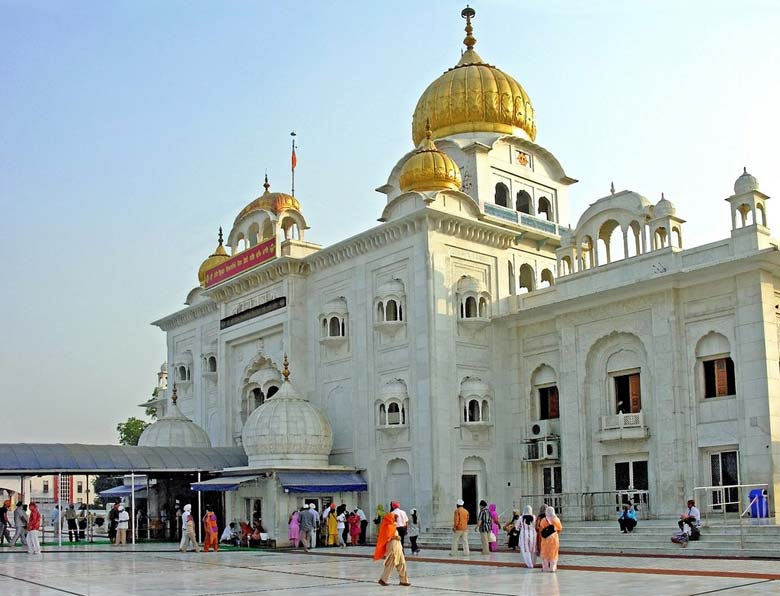
Sisganj Gurudwara
A Sikh shrine near the police station on Chandni Chowk, Sisganj Gurdwara is a restful place to take a break from the crowds. It marks the site where Aurangzeb beheaded Guru Teg Bahadur in 1675 when the guru refused to convert to Islam. Women must cover their heads.
#7. Sweitana Temple
The interior of this splendid Jain temple is majestic, with painted murals and sacred idols.
Tourist Places to Visit in Central Delhi / South Delhi
New Delhi
NeW Delhi, which begins in Connaught Place (Also Read Things to do in Connaught Place) and extends up to 6 km (4 miles) south, is the city the British built when they moved their capital from Calcutta to Delhi in 1911. Its leafy colonial bungalows are slowly being replaced with office buildings, five-star hotels, and unsightly new residential quarters for government officials. New Delhi flows into South Delhi; the boundary is fluid. South Delhi also has its share of centuries-old monuments, such as the Qutab Minar, the village of Hauz Khas, and numerous Muslim tombs that lie abandoned in the center of a field or stand amid contemporary houses and apartments. Eastern South Delhi has the handsome new Bahai Temple.
Visit Tourist Places in Delhi
Hire a car or taxi and head to Humayun’s Tomb in the early morning. Created by the wife of the Mogul emperor, the 16th-century tomb is relatively peaceful at this time of day. Once the rush-hour traffic winds down, proceed north to Puranala, on your way to the Crafts Museum. Don’t rush through the museum; give yourself ample time to appreciate the excellent displays and lovely creations. From here, head southeast to Dilli Haat and the INA Market, a wonderful shopping-and-eating complex. After a snack, drive up to Baba Bangla Sahib Gur-dwara to see Sikhism in action. On the trip back south, drive west along Raj Path to Lutyens’s Imperial City, with its impressive architecture. Chill out for a bit in Lodi Gardens , where peace descends once again as you take an afternoon stroll to see the locals relax and examine the ancient tombs of the 15th- and 16th-century Lodi rulers. Around 5 PM, head to the nearby old Nizamuddin neighborhood and its wonderful, ethnically rich Muslim bazaar. Taped qawwali s (Sufi songs of ecstasy) set the mood as you walk down winding lanes to Hazrat Nizamuddin Darga, the tomb of a Sufi saint. Buy some flowers to place on the tomb when you arrive. Tomb administrators are descen-dams of the Sufi saint, and they can serve as useful guides to this little treasure, a perfect place to linger as the sun goes down. If you’re lucky, the sun will set to the sound of qawwali singers performing their riveting songs live. Finally, take a ride to the lotus shaped Bohai Temple which is open until 7 PM.
Timing
This tour takes a full day if traffic slows you down, and it probably will. If you have time, you might want to divide the itinerary into two days and relax the first afternoon, then start a bit later the second day. Between April and October, when the sun is intense, consider splitting the tour in half just to prevent dehydration or sunstroke. Try not to plan this tour for a Monday, when the Crafts Museum is closed.
#8. Bangla Sahib Gurdwara
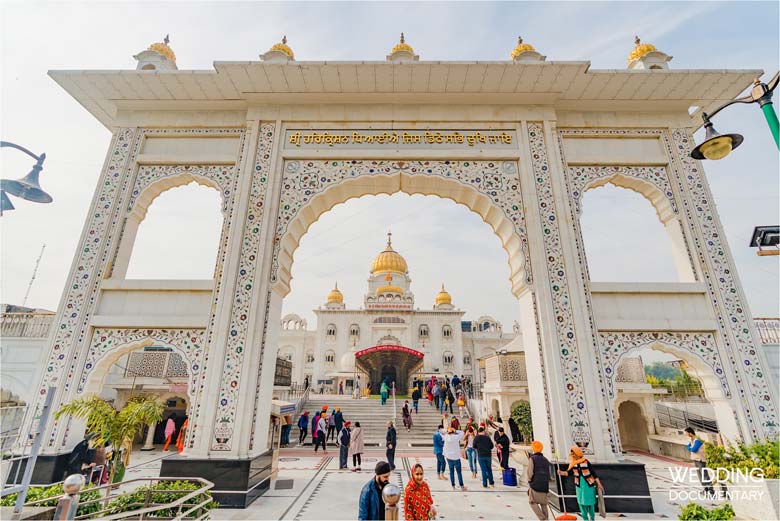
Bangla Sahib Gurudwara
Less than a mile (2 km) from Connaught Place, this gurdwara (Sikh temple) is always full of activity—no surprise given Delhi’s huge Sikh population, most of whom came here as refugees from Pakistan in 1947. Today the Sikhs are a prosperous group, many arriving for prayers by car or motorcycle. If you can’t make it to Amritsar to see the Golden Temple, by all means come to Bangla Sahib to see Sikhs worship and to admire the distinctively ostentatious style of their temples. Like Sikhism itself, gurdwaras reflect both the symmetry of Mogul mosques and the chaos of, Hindu temples. Bangla Sahib is built of blinding white marble with a shiny, gold onion dome on top. There is a large tank of water off to the right, surrounded by a deep marble veranda that offers relief from the sun on hot days.
The gurdwara stands on the site where Guru Hari Krishan, the eighth of 10 Sikh gurus who lived between 1469 and 1708, performed a small miracle. Before entering, remove your shoes and socks (check them at the counter on the left), get rid of cigarettes, and bring or find a piece of cloth to cover your head. As you walk up the stairs and enter the sanaum, you’ll see people filling jugs of water from enclosed cisterns. Guru Hari Krishan used to distribute sanctified water to the sick, believing it had a miraculous healing effect on their mind, body, and soul, and people still treat the contents of these pools as holy water. Inside, devotees sit facing a small pavilion in the center that holds the Granth Sahib (Sikh scriptures). Hymns from the holy book are sung continuously from well before sunrise until approximately 9 PM, and you’re welcome to sit and listen for a while; if you fancy something cultural in the evening, come at about 9 to see the ceremony by which the book is stored away for the night. As you walk around inside, be careful to proceed in a clockwise direction, and exit on the right side in back. Out the door to the right a priest distributes prasad, or communion: Take a lump of this sugar, flour, and oil concoction with both hands, pop it into your mouth with your right hand, then rub the remaining oil into your hands.
#9. Bahai Temple
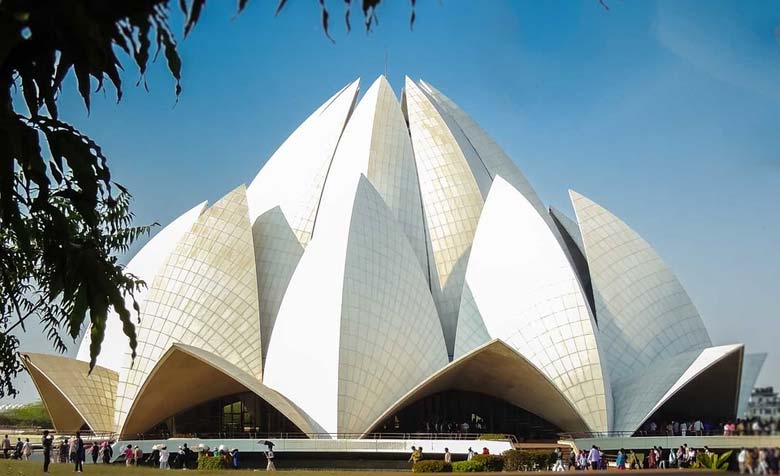
Bahai Temple Delhi
The Bahai Temple celebrates the lotus flower, symbol of purity throughout India, and the number nine, which represents the highest digit and, in the Bahai faith, unity. The nine pools on the elevated platform signify the green leaves of the lotus and cool the stark, smooth, elegant interior. The sleek structure has two layers: nine white marble-covered petals that point to heaven, and nine petals that conceal the portals. From a short distance, it looks like a fantastic work of origami rising out of the earth. The interior conforms to that of all Bahai temples: There are no religious icons, just copies of the Holy Scriptures and sleek wooden pews. Completed in 1986, the temple was designed by Fariburz Sahba, an Iranian-born Canadian architect.
#10. Crafts Museum
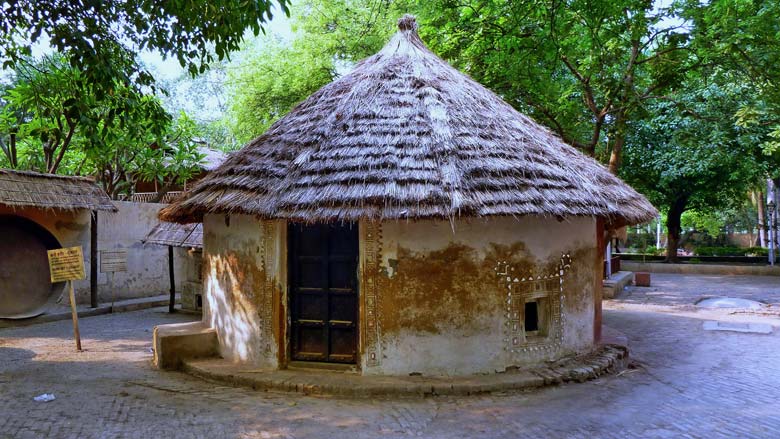
Crafts Museum Delhi
Designed by the architect Charles Correa, this charming complex houses more than 20,000 artifacts and handicrafts from all over India. Located near the Old Fort, it’s a great respite from Delhi’s crowds and intensity, with terra-cotta sculptures from Tamil Nadu dot-ting the spacious grounds. The Folk and Tribal Art Gallery—a delightful mix of village and tribal India—has objects fashioned out of locally available materials, highlighting in various ways the mythology, ingenuity, and whimsy that characterize so much of India’s folk art. A wooden temple car (built to carry deities in festive processions) stands in an open courtyard that leads to more buildings, including a lavishly decorated two-story Gujarati haveli. The Courtly Crafts section illustrates the luxurious lifestyle of India’s onetime royalty. An upper floor celebrates the country’s superb saris and textiles: brocades, embroideries, mirror work, and appliqués. In the village complex, with replicas of rural homes, artisans demonstrate their skills (weather permitting) and sell their creations. The museum has a shop and a snack bar.
#11. Gandhi Smriti
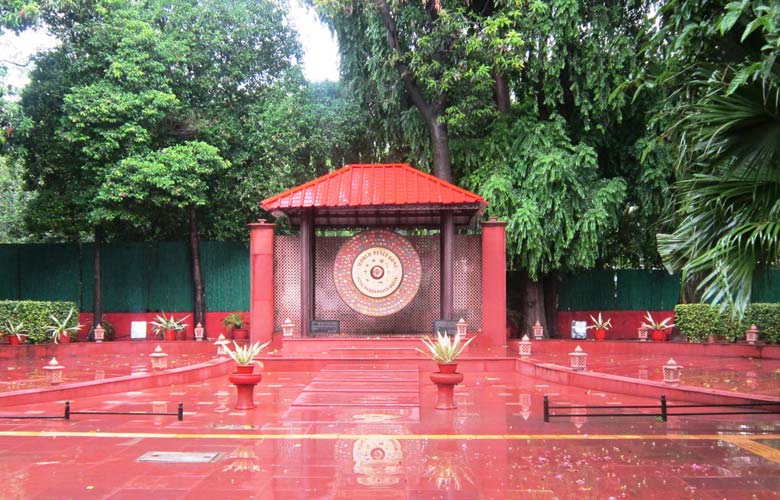
Gandhi Smriti
While Mahatma Gandhi lived a life of voluntary poverty, he did it in some attractive places. It was in this huge colonial bungalow, designed by a French architect for Indian industrialist G. D. R. Birla that Gandhi was staying as a guest when he was assassinated. Gandhi’s bedroom is just as he left it, with his “worldly remains” (only 11 items, including glasses and a walking stick) mounted on the wall. Pictures and text tell the story of Gandhi’s life and the Independence movement; there is also a collection of dioramas depicting events in Gandhi’s life.
#12. Hauz Khas
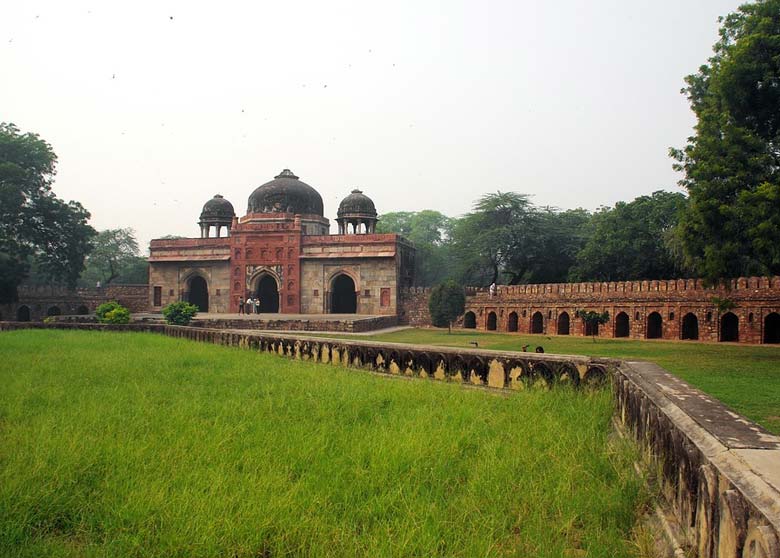
Hauz Khas Village Delhi
The road south to the village of Hauz Khas is lined on both sides by ancient stone monuments, and the entire village itself is dotted with domed structures, the tombs of minor Muslim royalty from the 14th to the 16th centuries. At the end of the road, all the way through the congested little village, is the tomb of Firoz Shah Tughluq; who ruled Delhi in the 14th century. Hauz Khas means “Royal Tank,” referring to the now empty artificial lake visible from Firoz Shah’s pillared tomb. The tank was actually built a century earlier by Allaudin Khiji as a water source for his nearby fort, and then called Siri (the second city of Delhi; now the Asian Games Village, having housed athletes). Firoz Shah repaired the tank and built the now crumbling madrasa (Islamic college) on the edges of the tank. Wander around the ruins at leisure, and if you have energy left over, walk around the large tank with South Delhi’s exercisers.
Back in the village itself, wander through the narrow galis (alleyways), where old and new exist in stark juxtaposition. In the 1980s Huaz Khas was designated an upscale tourist destination, but, fortunately, the process of redevelopment was never fully completed, so some of the village character persists. Check out the latest art gallery or stop into a jewelry shop; just watch your step or you may trip over a buffalo, chewing its cud as it lies on a bed of straw. After exploring, stop for a meal at one of the village’s numerous restaurants, particularly Park Baluchi (a 5-minute walk to Deer Park) or Naivedyam .
#13. Hazrat Nizamuddin Dargah
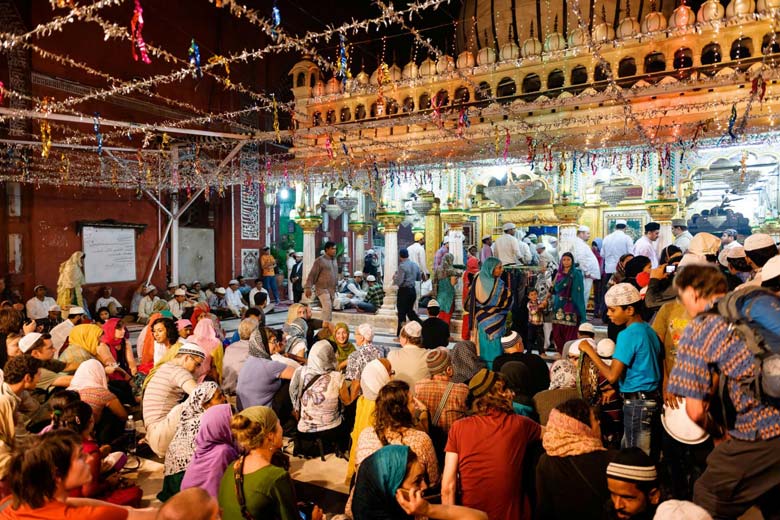
Hazrat Nizamuddin Dargah
Here you may have a chance to enjoy one of Delhi’s greatest treats—hearing devout Sufis sing qawwalis, hypnotically intense songs of religious ecstasy. To get here, follow the twisting narrow lanes in Nizamuddin, an old neighborhood about 3 km (2 mi) east of the Lodi Gardens—a smaller version of Chandni Chowk. You’ll pass open-air stalls selling Islamic religious objects, butchers chopping buffalo meat (often with the knife held between dexterous toes), small restaurants cooking simple Indian meals and paratha (unleavened bread) that is given to the poor at day’s end, and tiny shops selling cassettes, many by famous qawwali singers. When you see vendors selling flowers and garlands, you’re getting close to the shrine (dargah) of Hazrat Nizamuddin Aulia. Buy a few garlands (about Rs. 10 each) to present at the memorial for this Sufi saint, who died in 1325.
When you’re asked to remove your shoes, you’ve arrived at the tomb’s entrance. Within the small courtyard, considered extremely sacred, are three small mausoleums. The saint’s tomb has a white, onion-shaped dome with thin black stripes, and the largest crowd of visitors. It’s surrounded by a mosque and the graves of other important Muslims, including a daughter of the Mogul emperor Shah Jahan and another relative of the emperor Akbar, the 16th-century conqueror and reformer.
Hazrat Nizamuddin Aulia was born in Bukhara and later came to Delhi, where he became an important Sufi mystic with a dedicated following. His white mausoleum was built in 1562 after the destruction of two earlier tombs. Architecturally, the structure is modest: a little jewel that grows prettier the longer you study its inlay work and the carved parapet above the verandas. Evenings from around. 5 to 7, especially Thursdays, the Sufi saint’s male followers often (not always) sing their songs of ecstasy. You can sit in the courtyard and listen as the singers wail and gesture lovingly with their hands.
#14. Humayun’s Tomb
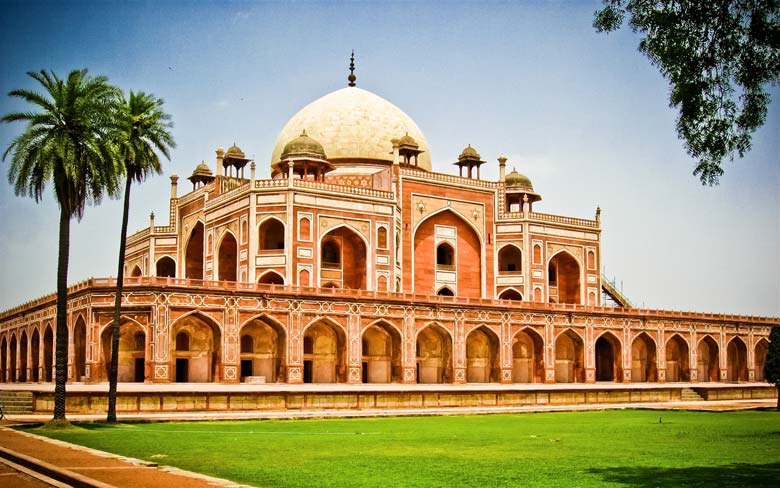
Humayun’s Tomb Delhi
Erected in the middle of the 16th century by the wife of the Mogul emperor Humayun, this burial place introduced a new architectural era that culminated in the Mogul work of arts in Agra and Fatehpur Sikri. The Moguls brought to India their love of gardens and water fountains, and left a legacy of unified structures, such as this mausoleum, that fuse balance with Oriental splendor.
Besides Humayun, seven other important Moguls are buried here, along with Humayun’s wife, Haji Begum—who lies in the beautifully dilapidated octagonal shrine outside the gateway—and possibly his bar-ber. As you enter or leave the gateway, stand a moment for the square, blue-domed structure to enjoy the view of the entire monument framed in the arch. The building’s serenity belies the fact that many of the dead buried inside were murdered princes, victims of foul play.
#15. Lodi Gardens in Delhi
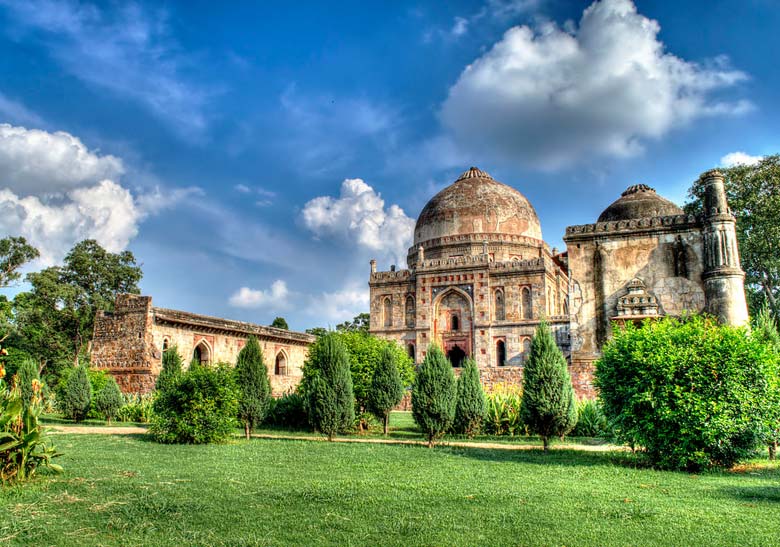
Lodi Gardens Delhi
After Timur ransacked Delhi at the end of the 14th century, he ordered the massacre of the entire population—acceptable retribution, he thought, for the murder of some of his soldiers. As if in unconscious response to this horrific act, the subsequent Lodi and Sayyid dynasties built no city, only a few mosques and some mausoleums and tombs, the latter of which stand in what is now a lovely urban park. Winding walks cut through landscaped lawns with trees and small flowers, past schoolboys playing cricket and groups of friends relaxing in the greenery.
#16. Lutyens’s Imperial City
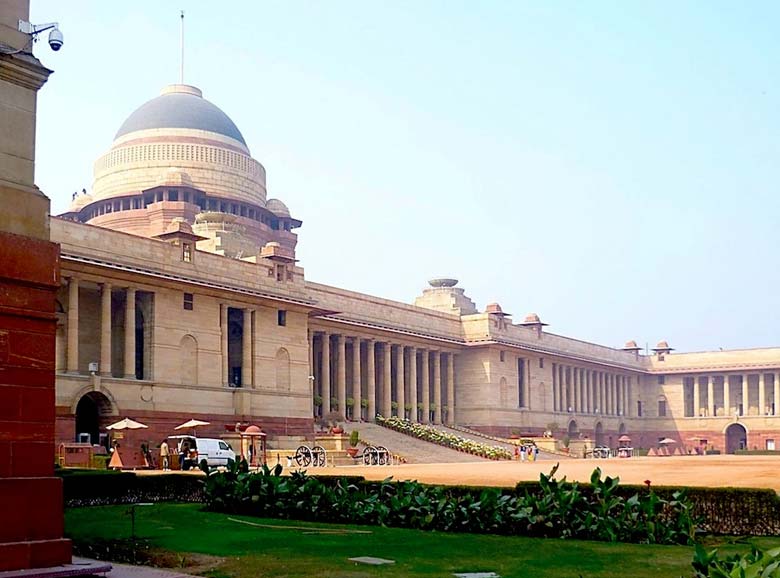
Lutyens’s Imperial City
Raj Path– the broadest avenue in Delhi– results in Delhi’s eighth capital: Sir Edwin Lutyens’s Imperial City, built between 1914 and 1931 in a symbolically imperialistic style. Beginning from India Gate at the lowest and eastern end of Raj Path, neighboring land was allocated to many princely states, which built small palaces, such as the Bikaner House (now the Rajasthan tourism workplace) and Jaipur House (now the National Gallery of Modern Art). It might be stated that this positioning mirrored the British sentiments toward the princes, who lost much of their previous power and status throughout the British Raj. Moving up the slowly inclining hill at the western end of the opportunity, you also move up the British ladder of power, an idea fundamental in the initial style. Initially, you come to the huge North and South. Secretariats, facing each other on Raj Path and reflecting the significance of the administration, a fixture of Indian society considering that the time of British rule. Identical in style, the 2 structures have 1,000 rooms and miles of passages.
Directly behind the North Secretariat is Sansad Bhavan, a circular building in red-and-gray sandstone with an open colonnade that extends around the circumference. Architecturally, the Indian design is meant to mirror the spinning wheel that was the symbol of Mahatma Gandhi, but the building’s placement (off of the main avenue) may suggest the attitude of the British toward the legislative assembly that was made up of Indians: not the ruling force.
At the top of the hill is the former Viceroy’s House, now called Rashtrapati Bhavan, where the President of India (distinct from the prime minister) now resides. Though it was built in the 20th century, the building’s daunting proportions seem to reflect an earlier, more lavish time. Its scale was meant to express British supremacy. The Bhavan contains 340 rooms and its grounds cover 330 acres, including a Mogul-style garden that opens to the public for several weeks in February. The shape of the central brass dome, the palace’s main architectural feature, copies that of a Buddhist stupa (shrine).
The execution of Lutyens’s design has two ironic twists. The entire palace was supposed to fill the vista as you approach the top of the hill, but because the gradient is actually too steep, only the dome dominates the horizon. And, of course, a few years after the Imperial City was completed, the British packed up and went home, and all of this be-came the grand capital of newly independent India. Permission to enter Rashtrapati and Sansad Bhavan is almost impossible to obtain; unless you have contacts in high places, satisfy yourself with a glimpse from outside.
#17. National Gallery of Modern Art in Delhi
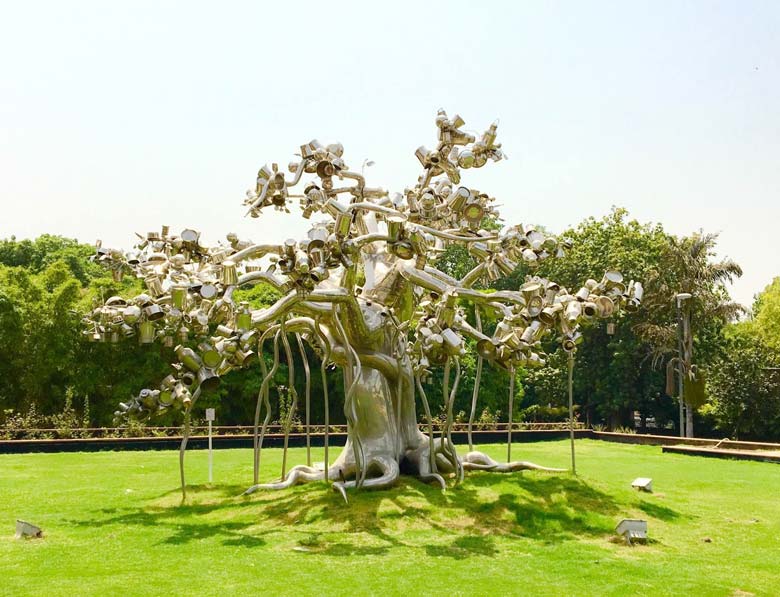
National Gallery of Modern Art Delhi
Facing India Gate, this neoclassical building was built by the British in the early 20th century as a palace for the maharaja of Jaipur. With its small dome and large, open rooms, the structure makes a beautiful space for an art museum, and it’s well maintained. The museum was established in 1954 to preserve Indian art forms (mainly painting) that have emerged since about 1850. The collection is broad, and well displayed by local standards, but still some-what uneven and oddly arranged. The highlights—Bengali Renaissance works by such artists as Rabindranath Tagore and Jamini Roy—are all but hidden away in corner rooms upstairs, and the works chosen to represent contemporary masters such as M. E Husain and Ganesh Pyne are disappointing. Documentaries shown daily at 11 AM and 3 PM discuss Indian art, but works in the museum are not contextualized with written commentary.
#18. National Museum
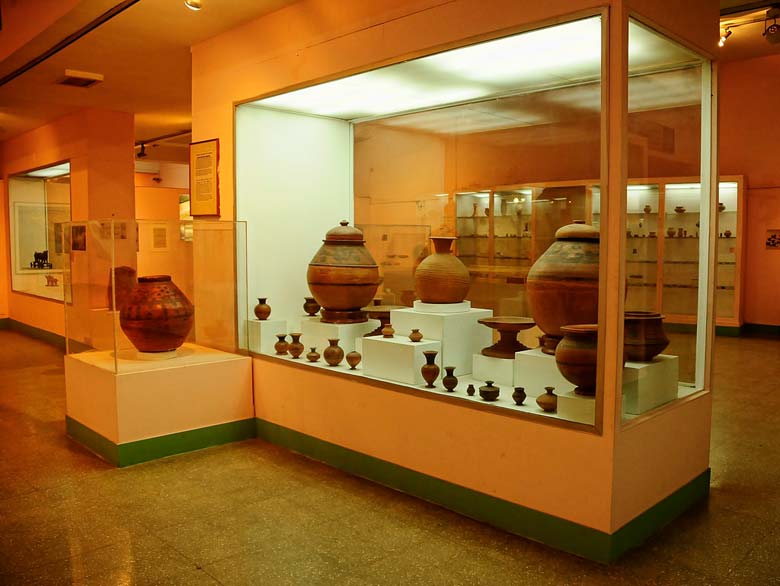
National Museum Delhi
The facade of this grand building imitates Lutyens’s Rashtrapati Bhavan: A sandstone dome is supported by classical columns of brown sandstone on a red sandstone base. Upon entering, you’re greeted by a 13th-century idol of Surya, the sun god, standing beneath the dome. The statue is emblematic of the National Museum’s strength ancient, mostly Hindu, sculptures. One whole room is dedicated to artifacts from the Indus Valley Civilization, circa 2,700 BC, while others display works from the Gandharan, Chandela, and Chola periods. In addition to sculpture, exhibits feature jewelry, painting, musical instruments, coins, carpets, and weapons. Alas, the museum is not terribly well maintained, and there’s no brochure to aid your wandering.
#19. Nehru Memorial Museum
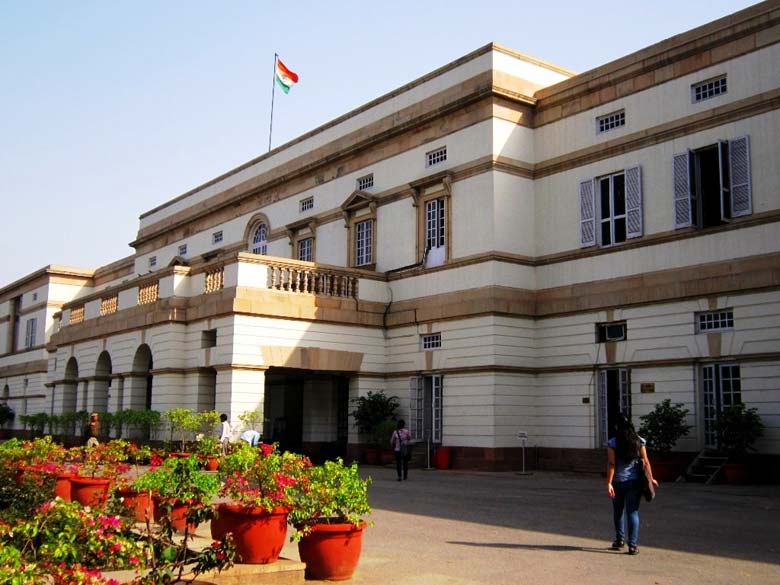
Nehru Memorial Museum
This massive colonial mansion was originally built for the commander of the British Indian Army. While the Vice regal residence (framed at the other end of South Avenue) became the home of India’s president, India’s first prime minister, Jawaharlal Nehru, took up residence here. Those interested in the Independence movement should not miss this landmark, nor the nearby Gandhi Smriti above). The yellow two-story building is surrounded by beautiful flower gardens and punctuated by grand trees. Inside, several rooms are still decorated as Nehru left them, and extensive displays chroni-cle Nehru’s life and the Independence movement. Move through the rooms in order: One by one, photographs, newspaper clippings, and personal letters tell the heart-stopping story of the birth of the world’s largest democracy. On your way out, stop to see the 14th-century hunting lodge next to the Nehru Planetarium. (The latter, good for kids, has shows in English at 11:30 AM and 3 PM.)
#20. Purana Qila (Old Fort)
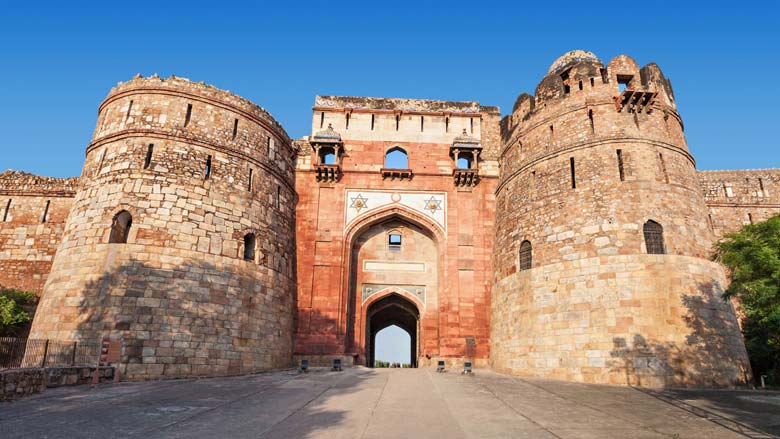
Purana Qila Delhi
India’s sixth capital was the scene of a strong power struggle between the Afghan Sher Shah and Humayun, boy of the first Mogul emperor, Babar. Humayun, who believed deeply in astrology, probably considered himself star-crossed. When he began to build his own capital, Dinpanah, on these premises in the 1530s, Sher Shah forced the emperor to flee for his life. Sher Shah damaged what existed of Dinpanah to produce his own capital, Shergarh. Fifteen years later, Humayun took vengeance and seized control, however he passed away the list below year, leaving Sher Shah’s city for others to damage.
Regrettably, when you get in the huge Bara Darwaza (Western Gate), only two structures are intact: the Qila-i-Kunha Masjid, Sher Shah’s personal mosque, an excellent example of Indo-Afghan architecture in red sandstone with decorative marble touches, and the two-story octagonal tower of red sandstone and white marble, the Sher Mandal, which eventually became Humayun’s library and his death trap: Hearing the call to prayer, Humayun started down the high actions, slipped, and fell to his death.
#21. Qutab Minar
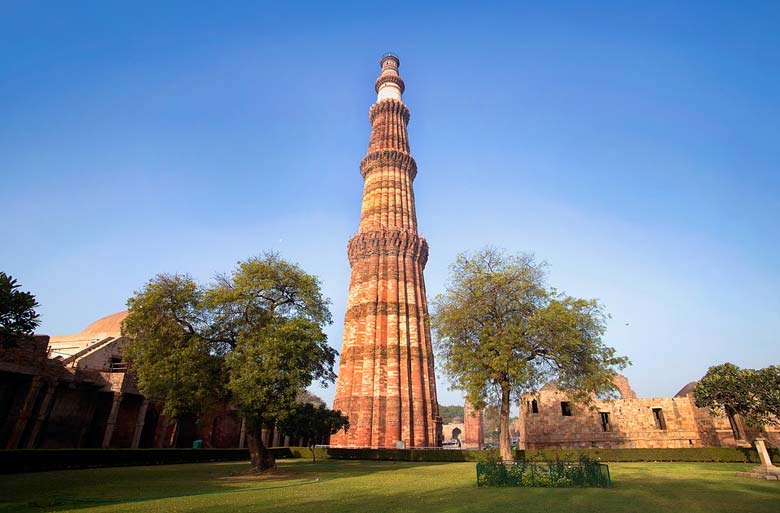
Qutab Minar Delhi
This 234-ft tower, called the seventh wonder of Hindustan, is the tallest stone tower in India, with 376 steps. Begun by the Muslim campaigner Qutab-ud-din-Aibak in 1193 to commemorate his capture of Delhi, it was completed by his son-in-law and successor, Il-tutmish, who added the top four stories. This combined effort led to a handsome sandstone example of Indo-Islamic architecture with terra-cotta frills and outbursts of balconies to mark each story. Unfortunately, repairs by a 14th-century ruler destroyed the harmonious lines, adding not only height and marble to the two upper stories, but a silly dose of incongruity. The lower sandstone sections are fluted, with vertical lines; the renovation adopted a round motif with horizontal lines. The rulers also changed the degree of the taper. The decorative bands of intricately carved inscription are Arabic quotations from the Koran.
At the foot of the Qutab Minar lies the Quwwat-ul-Islam Masjid, the first Muslim mosque in India, erected in the 12th century after Muslims defeated the Hindu Chauhan dynasty and created the first capital not far from here. As if to prove their supremacy over the Hindus, the Muslims built their mosque on the site of a Hindu temple and used materials, especially columns, from 27 other demolished Hindu and Jain shrines, with the result that Hindu and Jain sculptures stand in various parts of the mosque. Because the mosque was probably built by Hindu craftsmen, the presence of the large stone screen across the front of the prayer hall may have been the Muslims’ own attempt to block out the strong Hindu influence.
The mosque is also famous for a strange, 5th-century iron pillar, which originally stood before a temple of Vishnu and may have been brought here in the 11th century. A solid shaft of iron 24 ft high, the pillar is inscribed with six lines of Sanskrit. No one knows why it has remained rust-free for so many years. According to legend, if you stand with your back to the pillar and can reach around and touch your fingers, any wish you make will come true.
#22. Raj Ghat and National Gandhi Museum
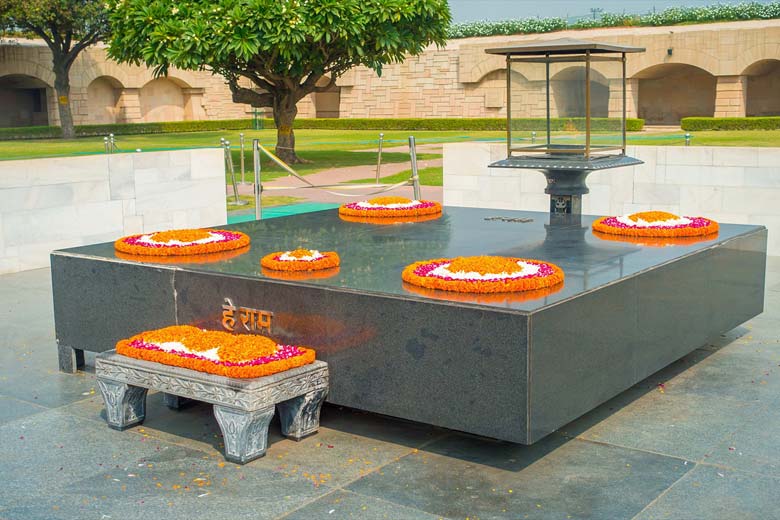
Raj Ghat Delhi
After Mohandas K. Gandhi was shot and killed by a Hindu fanatic on January 30, 1948 (the anniversary of which is now a national holiday), his body was cremated on the banks of the Yamuna River in Delhi. This site is now a national shrine to the Mahatma, as he is known (the honorific means “Great Soul”). Indian tourists and pilgrims from all walks of life stream across the peaceful lawn to pay their respects to “Gandhiji.” At the center of a low, modern courtyard is a slightly raised black-marble slab covered with flowers. At its head are an eternal flame and an inscription of Gandhi’s final words, “Hai Ram!” (“Oh God!”). The sandstone walls enclosing the shrine are inscribed with various passages written by Gandhi, translated into India’s 13 national languages as well other languages, such as Spanish and Zulu. Raj Ghat was also the cremation site for two other assassinated heads of state, Indira Gandhi and her son, Rajiv. Back across the busy street from which you entered is the National Gandhi Museum, run by a private foundation, which houses a collection of photographs and sonic of Gandhi’s personal effects.
For more information on Delhi Sightseeing Tour by Car, Contact Swan Tours – One of the leading Travel Agents in Delhi, India operating since 1995.
